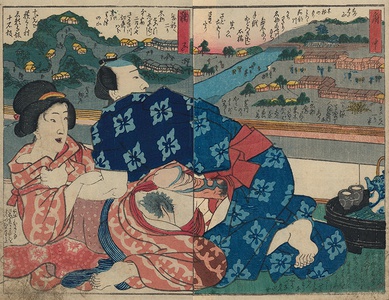| Method | Woodblock (nishiki-e) |
| Artist | Koikawa Shozan (1821-1907) |
| Published | c. 1850 |
| Dimensions | Two chūhon sheets [each sheet ~180 x 120 mm] |
| Notes |
Series: The Fifty-three Stations of the Tōkaidō Road A print from Koikawa Shozan's The Fifty-three Stations of the Tōkaidō Road. Here a woman reclines, her kimono open leaving her exposed while the aroused man who crouches above her, also exposed, holds her kimono closed at the top with his left hand as he looks over his right shoulder. To the side of them sits a tea set, and behind them views of Fuchū on the right and Mariko on the left. This print is an example of a genre of shunga based on meisho-ki (guide books) and their equivalent print series depicting stops along travel routes. These erotic versions depict sexual encounters at various stops along the journey and in this case based on the 53 stations on the Tōkaidō Road. Shunga is the term used for the body of erotic imagery produced in Japan from 1600 to 1900. The term shunga means spring pictures, a euphemism for sex, and is one of several names for erotic material produced in Japan. Shunga took different formats: painted hand scrolls, painted books, printed books and albums, and sets of prints which were sometimes sold in wrappers. As prints they are one of the genres of ukiyo-e, or Floating World prints, which also include fukeiga (landscape prints), and bijin-ga (prints of beautiful women). Most of the major ukiyo-e artists produced shunga material at some point during their careers, including Utamaro (who produced more erotic books than non-erotic books), Hokusai, and Hiroshige. Produced at the same time as the introduction of full colour woodblock printing, shunga prints and books were made using the most lavish and complicated printing techniques, including gauffrage, metallic inks, mica, complicated printed patterns, and multicolour printing using a high number of different colours. Although prolific in its number and variety, shunga should be seen as more representative of the ideals of the ukiyo, with its emphasis on mutual pleasure, rather than as an accurate representation of Japanese attitudes and practices of sexuality. Shunga present an invitation to pleasure through the bliss of lovemaking and though largely heteronormative, they portray the full gamut of couplings, married or otherwise, often surrounded by lavish settings and objects of pleasure. Koikawa Shozan (1821-1907) was an Edo printmaker who worked in the Edo and Meiji periods and seems to have only made shunga prints. Ex. col.: Peter Darach Condition: Rubbing and soiling to lower left and right corners. |
| Framing | unmounted |
| Price | £175.00 |
| Stock ID | 53213 |

